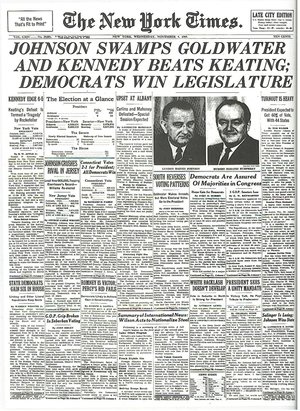U.S. presidential election, 1964
|
|
ElectoralCollege1964-Large.png
The assassination of John F. Kennedy in 1963 created a unique climate for the U.S. presidential election of 1964. Supporters were saddened by the loss of the charismatic president, while opposition candidates were in the awkward situation of running against the policies of a martyred president.
| Contents [hide] |
Nominations
Democratic Party nomination
During the mourning period following the assassination of President Kennedy, Republican leaders called for a political moratorium, perhaps so as not to appear disrespectful. Most political pundits agreed the political outlook following the assassination of the president was quite unclear for some time. The new president, Lyndon B. Johnson, capitalized on this situation, using a combination of the national mood and his own political savvy to push Kennedy's agenda; most notably, the Civil Rights Act of 1964. By the time of the national convention, Johnson was unassailable, and easily won the Democratic nomination.
At that time there was no provision for replacing a Vice President, so the office had remained vacant. Johnson chose Senator Hubert H. Humphrey as his running mate.
Republican Party nomination
The Republican Party was more divided. Richard Nixon, who had been beaten by Kennedy in a close election, and subsequently lost the 1962 election for Governor of California, decided not to run. Barry Goldwater, a Senator from Arizona, was the champion of the conservative wing of the party, which was dissatisfied with what it perceived as the dominance of the party's Eastern liberal wing. Goldwater was opposed most notably by Nelson Rockefeller, the Governor of New York, and William Scranton, the Governor of Pennsylvania.
In the New Hampshire primary, the voters gave a surprising victory to the Ambassador to South Vietnam, Henry Cabot Lodge, Jr., Nixon's running mate in 1960 and a former Massachusetts senator, who was a write-in candidate.
Despite this defeat, Goldwater won the nomination, helped partly by an endorsement from Nixon. In accepting his nomination, he uttered his most famous phrase: "I would remind you that extremism in the defense of liberty is no vice. And let me remind you also that moderation in the pursuit of justice is no virtue."
General election
Campaign
Although Goldwater had been successful in rallying conservatives, his charisma seemed to be inadequate for the general election. Shortly before the Republican convention, he had alienated some Republicans by his vote against the Civil Rights Act of 1964, which Johnson championed and signed into law. Goldwater argued that it was a matter for the individual states rather than federal legislation. Earlier comments followed Goldwater throughout his campaign. Once he called the Eisenhower administration "a dime store New Deal," and the former president never fully forgave him. In December 1961 he told a news conference that "sometimes I think this country would be better off if we could just saw off the Eastern Seaboard and let it float out to sea." That comment came back to haunt him, in the form of a Johnson television commercial, as did remarks about making Social Security voluntary and selling the Tennessee Valley Authority.
Eisenhower’s strong backing could have been an asset to the Goldwater campaign, but instead its absence was clearly noticed. When questioned about the Presidential capabilities of Milton S. Eisenhower in July of 1964, Goldwater replied "One Eisenhower in a generation is enough". The former president did, however, agree to appear in one Goldwater television advertisement.
Johnson positioned himself as a moderate, and succeeded in portraying Goldwater as an extremist. Goldwater had a habit of making blunt statements about war, nuclear weapons, and economics that could be turned against him. Most famously, the Johnson campaign broadcast a television commercial dubbed the "Daisy Girl" ad, which featured a little girl picking petals from a daisy in a field, counting the petals, which then segues into a launch countdown and a nuclear explosion. The ads were in response to Goldwater's advocacy of "tactical" nuclear weapons use in Vietnam. Another Johnson ad, "Confessions of a Republican", tied Goldwater to the Ku Klux Klan. Voters increasingly viewed Goldwater as a rightwing fringe candidate -- his slogan "In your heart, you know he's right" was successfully parodied by the Johnson campaign into "In your guts, you know he's nuts," or "In your heart, you know he might."
The Johnson campaign's greatest concern may have been voter complacency leading to low turnout in key states. To counter this, all of Johnson's broadcast ads concluded with the line: "Vote for President Johnson on November 3. The stakes are too high for you to stay home."
The election was held on November 3, 1964. Johnson crushed Goldwater in the general election, winning nearly 61 percent of the popular vote, the largest percentage ever recorded (i.e. since the 1824 election). In the end, Goldwater won only his native state of Arizona and five Deep South states that had been increasingly alienated by Democratic civil rights policies. Because states like Mississippi, Alabama, and Georgia had not voted Republican in any Presidential election since Reconstruction, this was a major transition point for the South, and an important step in the process by which the Democrats' former "Solid South" became a Republican bastion.
Results
Template:Start U.S. presidential ticket box Template:U.S. presidential ticket box row Template:U.S. presidential ticket box row Template:U.S. presidential ticket box other Template:End U.S. presidential ticket box
Source: U.S. Office of the Federal Register (http://www.archives.gov/federal_register/electoral_college/scores.html#1964)
See also
Template:Uspresidentialelections
Reference
External link
- 1964 election results: State-by-state Popular vote (http://www.multied.com/elections/1964state.html)

